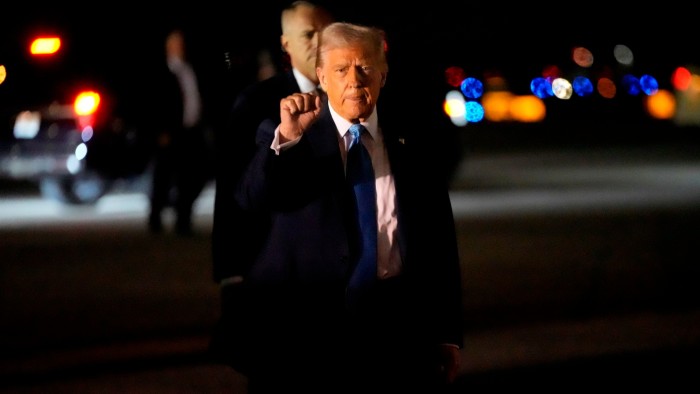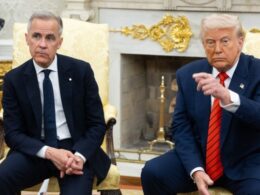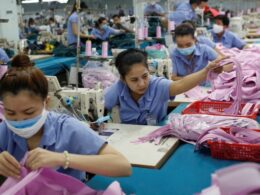Donald Trump has long declared himself a “tariff man” willing to impose sweeping levies on imports from countries that have hurt America.
But on Saturday, the 78-year old US president took the first dramatic step of his second term towards putting that vision into practice — placing trade wars and economic nationalism at the top of his agenda.
From his Mar-a-Lago estate in Florida, Trump unleashed aggressive new tariffs on imports from Canada, Mexico and China, a day after threatening the EU with high levies.
Trump is gambling that he can pressure US trading partners to comply with Washington’s wishes without triggering another damaging acceleration of inflation, at a time when the cost of living remains the top concern of many Americans.
For the world, Trump’s opening gambit on trade means a series of countries will be forced into bruising negotiations over everything from trade deficits and currency policy to immigration and even America’s new desire for territorial expansion. Financial markets could be shaken and the global economy may suffer.
“These tariffs herald a new era of US trade protectionism that will affect all American trading partners, whether rivals or allies, and will significantly disrupt international commerce,” says Eswar Prasad, a professor at Cornell University.
The hardest-hit economies will be Mexico and Canada given their heavy reliance on the US economy, with both facing outright recessions if Trump maintains the 25 per cent tariffs, economists said. The damage will be compounded by the fact that less than six years ago, those countries signed a new trade agreement with Trump in the hope that it would stabilise relations with the US.
“There are no safe havens,” says Brad Setser, a former US Treasury official now at the Council on Foreign Relations. “Two countries that struck the biggest trade deal with Donald Trump in his first term are the first two to get hit with tariffs.”
Neil Shearing, group chief economist at Capital Economics, said the macroeconomic effects would depend on how comprehensive the US tariff package was, and how quickly it gets imposed.
Some of the impact could be mitigated by appreciation of the dollar and substitution of domestically produced US goods, while corporations may choose to absorb some of the increase in costs via lower profit margins, economists said. But the magnitude of Trump’s first steps — if fully implemented — appeared far greater than the more limited trade wars against China and G7 allies during his last time in office.
“This could be a trade war on steroids,” said Ryan Sweet, chief US economist at Oxford Economics. “The first round was more targeted. Now they seem to be going across the board — and faster than I expected,” he added.
Everett Eissenstat, a former Trump economic adviser now at Squire Patton Boggs, said: “I expected the tariffs to go in in a more measured manner. But we can say there is one direction here, and that is that it seems to be escalating.”
The first tariffs on Mexico, Canada and China may only be the beginning. Trump officials have been considering imposing universal tariffs on all imports, and adding to the levies he imposed on Saturday.
Trump now wants to use tariffs to generate revenue to pay for the extension of trillions of dollars of tax cuts, which can only be achieved through carefully calibrated but hefty levies that could be hard to reverse.
“When it comes to raising revenue, if the tariff is too low it won’t raise enough money, if it’s too high it will stop trade and then you won’t make any money. They will need to find the sweet spot”, says Bill Reinsch of the Center for Strategic and International Studies.
As Trump doubles down on tariffs, he faces little resistance from business groups and free-market Republicans who have traditionally balked at his populist policies and sought to rein him in. Jim Risch, the Idaho senator who chairs the Senate foreign relations committee, cheered his latest moves.
“President Trump has always been very clear that if he sees Americans being taken advantage of, he won’t put up with it,” he said. Referring to Canada, Mexico, and China, he added: “These governments know very well that they need to stem the flow of drugs and illegal immigrants into our country. The sooner they do that, the better.”
But there are two big dangers for Trump. One would be a sell-off that sends equity markets and the value of Americans’ retirement plans plunging. The other would be that inflation picks up again after gradually falling towards its 2 per cent target over the past two and a half years.
Shearing said that Trump’s proposed measures could push headline PCE inflation above 3 per cent, compared with 2.6 per cent now. Hefty levies on the EU and China would push US price growth even higher, he warned.
“That is a big hit, especially for working families including people who voted for Trump on the rationale that he would reduce prices,” said James Knightley, chief international economist in the US at ING.
“The risks are we see some real pain for the household sector coming through later this year, especially if he expands tariffs on Europe.”
Democrats, who have been looking for ways to attack Trump early in his second term, have already pounced on the potential for higher inflation.
“Slapping huge tariffs on gas, groceries, phones, TVs and cars means working American families are going to pay more for the things they need,” said Ron Wyden, the Oregon senator, on Friday.
“These tariffs only make sense as class warfare, forcing typical Americans to foot the bill for another round of tax breaks for Trump and his rich buddies.”
Trump has found comfort in the fact that inflation remained subdued during the trade wars of his first term.
But Jay Powell, the chair of the Federal Reserve, noted last week that conditions had changed compared with the structurally low-inflation environment before the pandemic. “You’re coming through a situation where we’re not quite back to 2 per cent and that’s just different,” he said.
For the global economy, one potentially bleak scenario would be that of “massive supply shock”, said Knightley, similar to the shocks economies weathered during the Covid-19 pandemic.
“The risk is that this is going to be quite damaging, especially if we see a significant response. And I don’t see how politicians don’t respond.”
Source link









